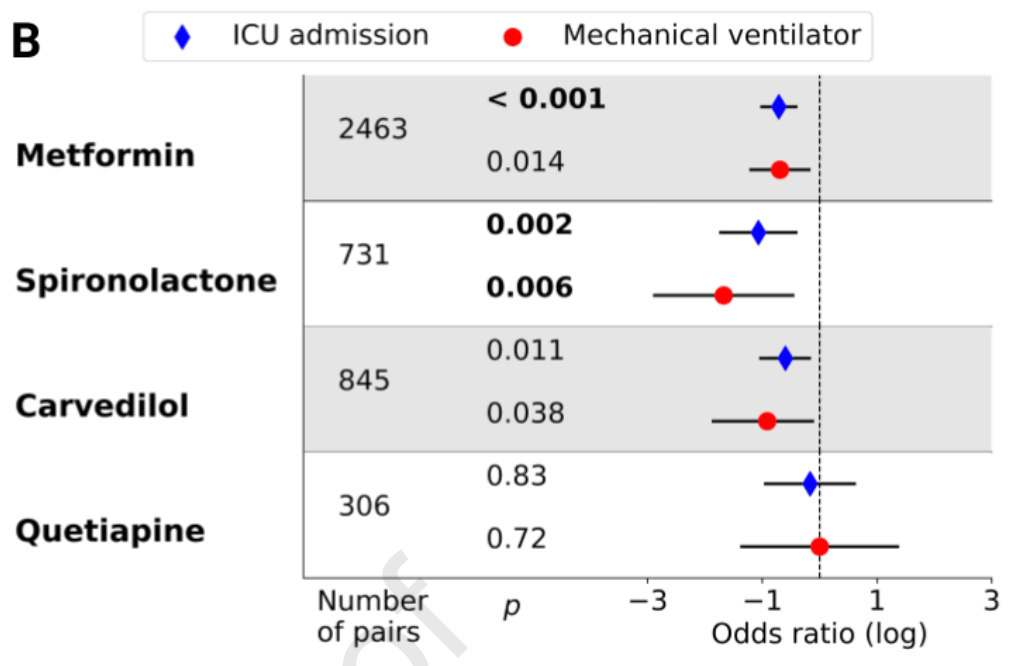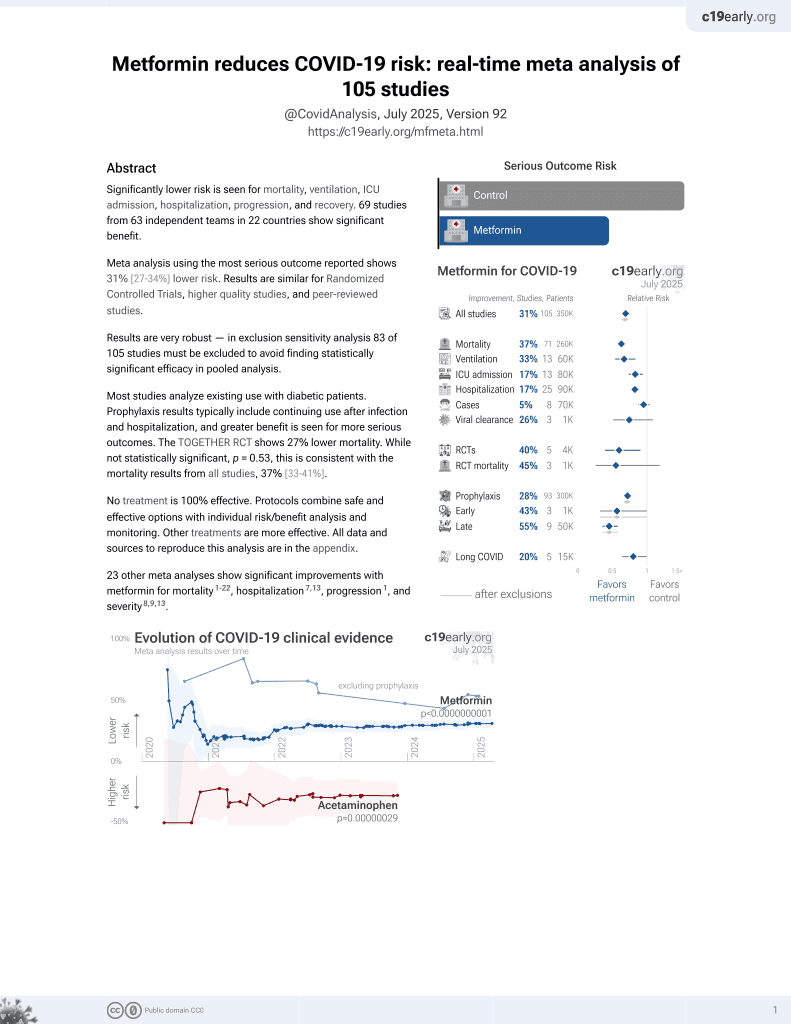
Integrative analysis of functional genomic screening and clinical data identifies a protective role for spironolactone in severe COVID-19
et al., Cell Reports Methods, doi:10.1016/j.crmeth.2023.100503, Jul 2022 (preprint)
Metformin for COVID-19
3rd treatment shown to reduce risk in
July 2020, now with p < 0.00000000001 from 107 studies.
Lower risk for mortality, ventilation, ICU, hospitalization, progression, recovery, and viral clearance.
No treatment is 100% effective. Protocols
combine treatments.
6,300+ studies for
210+ treatments. c19early.org
|
PSM retrospective 64,349 COVID-19 patients in the USA, showing metformin associated with lower ICU admission and mechanical ventilation.
Standard of Care (SOC) for COVID-19 in the study country,
the USA, is very poor with very low average efficacy for approved treatments1.
Only expensive, high-profit treatments were approved for early treatment. Low-cost treatments were excluded, reducing the probability of early treatment due to access and cost barriers, and eliminating complementary and synergistic benefits seen with many low-cost treatments.
Study covers metformin and spironolactone.
|
risk of mechanical ventilation, 50.0% lower, OR 0.50, p = 0.01, treatment 2,463, control 2,463, propensity score matching, RR approximated with OR.
|
|
risk of ICU admission, 51.0% lower, OR 0.49, p < 0.001, treatment 2,463, control 2,463, propensity score matching, RR approximated with OR.
|
| Effect extraction follows pre-specified rules prioritizing more serious outcomes. Submit updates |
Cousins et al., 6 Jul 2022, retrospective, propensity score matching, USA, peer-reviewed, 10 authors.
Contact: cousinsh@stanford.edu, russ.altman@stanford.edu, yuan.luo@northwestern.edu, congle@stanford.edu.
Integrative analysis of viral entry networks and clinical outcomes identifies a protective role for spironolactone in severe COVID-19
doi:10.1101/2022.07.02.22277181
Treatment strategies that target host entry factors have proven an effective means of impeding viral entry in HIV and may be more robust to viral evolution than drugs targeting viral proteins directly. High-throughput functional screens provide an unbiased means of identifying genes that influence the infection of host cells, while retrospective cohort analysis can measure the real-world, clinical potential of repurposing existing therapeutics as antiviral treatments. Here, we combine these two powerful methods to identify drugs that alter the clinical course of COVID-19 by targeting host entry factors. We demonstrate that integrative analysis of genomewide CRISPR screening datasets enables network-based prioritization of drugs modulating viral entry, and we identify three common medications (spironolactone, quetiapine, and carvedilol) based on their network proximity to putative host factors. To understand the drugs' real-world impact, we perform a propensity-score-matched, retrospective cohort study of 64,349 COVID-19 patients and show that spironolactone use is associated with improved clinical prognosis, measured by both ICU admission and mechanical ventilation rates. Finally, we show that spironolactone exerts a dose-dependent inhibitory effect on viral entry in a human lung epithelial cell line. Our results suggest that spironolactone may improve clinical outcomes in COVID-19 through tissue-dependent inhibition of viral entry. Our work further provides a potential approach to integrate functional genomics with real-world evidence for drug repurposing.
References
Abbasi, A Randomized Trial of Sitagliptin and Spironolactone With Combination Therapy in Hospitalized Adults With COVID-19, J. Endocr. Soc
Alfano, Hypokalemia in Patients with COVID-19, Clin. Exp. Nephrol
Arora, Comparable neutralisation evasion of SARS-CoV-2 omicron subvariants BA.1, BA.2, and BA.3, Lancet Infect. Dis
Austin, An Introduction to Propensity Score Methods for Reducing the Effects of Confounding in Observational Studies, Multivariate Behav. Res
Baggen, Genome-wide CRISPR screening identifies TMEM106B as a proviral host factor for SARS-CoV-2, Nat. Genet
Biering, Genome-wide, bidirectional CRISPR screens identify mucins as critical host factors modulating SARS-CoV-2 infection, bioRxiv
Bock, High-content CRISPR screening, Nat. Rev. Prim
Charlson, Pompei, Ales, Mackenzie, A new method of classifying prognostic comorbidity in longitudinal studies: development and validation, J. Chronic Dis
Crouse, Metformin Use Is Associated With Reduced Mortality in a Diverse Population With COVID-19 and Diabetes, Front. Endocrinol
Daly, Neuropilin-1 is a host factor for SARS-CoV-2 infection, Science
Daniloski, Identification of Required Host Factors for SARS-CoV-2 Infection in Human Cells, Cell
Dong, Spironolactone alleviates diabetic nephropathy through promoting autophagy in podocytes, Int. Urol. Nephrol
Filippo, Hypocalcemia is highly prevalent and predicts hospitalization in patients with COVID-19, Endocrine
Hoffmann, SARS-CoV-2 Cell Entry Depends on ACE2 and TMPRSS2 and Is Blocked by a Clinically Proven Protease Inhibitor, Cell
Horowitz, Genome-wide analysis provides genetic evidence that ACE2 influences COVID-19 risk and yields risk scores associated with severe disease, Nat. Genet
Kanehisa, Goto, KEGG: Kyoto Encyclopedia of Genes and Genomes, Nucleic Acids Res
Keidar, Mineralocorticoid receptor blocker increases angiotensin-converting enzyme 2 activity in congestive heart failure patients, Circ. Res
Kim, Characterization of heparin and severe acute respiratory syndromerelated coronavirus 2 (SARS-CoV-2) spike glycoprotein binding interactions, Antiviral Res
Klein, Luo, PsmPy: A Package for Retrospective Cohort Matching in Python in EMBC
Kotfis, Mineralocorticoid Receptor Antagonist (Potassium Canrenoate) Does Not Influence Outcome in the Treatment of COVID-19-Associated Pneumonia and Fibrosis-A Randomized Placebo Controlled Clinical Trial, Pharmaceuticals
Lalau, Metformin use is associated with a reduced risk of mortality in patients with diabetes hospitalised for COVID-19, Diabetes Metab
Li, Metformin in Patients With COVID-19: A Systematic Review and Meta-Analysis, Front. Med
Liberzon, The Molecular Signatures Database (MSigDB) hallmark gene set collection, Cell Syst
Lobritz, Ratcliff, Arts, HIV-1 Entry, Inhibitors, and Resistance, Viruses
Luo, Metformin Treatment Was Associated with Decreased Mortality in COVID-19 Patients with Diabetes in a Retrospective Analysis, Am. J. Trop. Med. Hyg
Mannar, SARS-CoV-2 Omicron variant: Antibody evasion and cryo-EM structure of spike protein-ACE2 complex, Science
Meng, Altered TMPRSS2 usage by SARS-CoV-2 Omicron impacts infectivity and fusogenicity, Nat
Muus, Single-cell meta-analysis of SARS-CoV-2 entry genes across tissues and demographics, Nat. Med
Rahmani, Attenuation of SARS-CoV-2 infection by losartan in human kidney organoids, iScience
Ravindra, Single-cell longitudinal analysis of SARS-CoV-2 infection in human airway epithelium identifies target cells, alterations in gene expression, and cell state changes, PLoS Biol
Rebendenne, Bidirectional genome-wide CRISPR screens reveal host factors regulating SARS-CoV-2, MERS-CoV and seasonal coronaviruses, bioRxiv Prepr. Serv. Biol, doi:https:/doi.org/10.1101/2021.05.19.444823
Reis, Effect of early treatment with fluvoxamine on risk of emergency care and hospitalisation among patients with COVID-19: the TOGETHER randomised, platform clinical trial, Lancet Glob. Heal
Schneider, Genome-Scale Identification of SARS-CoV-2 and Pancoronavirus Host Factor Networks, Cell
Shang, Cell entry mechanisms of SARS-CoV-2, Proc. Natl. Acad. Sci. U. S. A
Sungnak, SARS-CoV-2 entry factors are highly expressed in nasal epithelial cells together with innate immune genes, Nat. Med
Takashita, Efficacy of Antibodies and Antiviral Drugs against Covid-19 Omicron Variant, N. Engl. J. Med
Tomlins, Recurrent fusion of TMPRSS2 and ETS transcription factor genes in prostate cancer, Science
Vanblargan, An infectious SARS-CoV-2 B.1.1.529 Omicron virus escapes neutralization by therapeutic monoclonal antibodies, Nat. Med
Velavan, Host genetic factors determining COVID-19 susceptibility and severity, EBioMedicine
Wang, Genetic Screens Identify Host Factors for SARS-CoV-2 and Common Cold Coronaviruses, Cell
Wilcox, Pitt, Is Spironolactone the Preferred Renin-Angiotensin-Aldosterone Inhibitor for Protection Against COVID-19?, J. Cardiovasc. Pharmacol
Wishart, DrugBank: a knowledgebase for drugs, drug actions and drug targets, Nucleic Acids Res
Zhu, A genome-wide CRISPR screen identifies host factors that regulate SARS-CoV-2 entry, Nat. Commun
Zhu, Genome-wide CRISPR activation screen identifies candidate receptors for SARS-CoV-2 entry, Sci. China. Life Sci
DOI record:
{
"DOI": "10.1016/j.crmeth.2023.100503",
"ISSN": [
"2667-2375"
],
"URL": "http://dx.doi.org/10.1016/j.crmeth.2023.100503",
"alternative-id": [
"S2667237523001327"
],
"article-number": "100503",
"assertion": [
{
"label": "This article is maintained by",
"name": "publisher",
"value": "Elsevier"
},
{
"label": "Article Title",
"name": "articletitle",
"value": "Integrative analysis of functional genomic screening and clinical data identifies a protective role for spironolactone in severe COVID-19"
},
{
"label": "Journal Title",
"name": "journaltitle",
"value": "Cell Reports Methods"
},
{
"label": "CrossRef DOI link to publisher maintained version",
"name": "articlelink",
"value": "https://doi.org/10.1016/j.crmeth.2023.100503"
},
{
"label": "Content Type",
"name": "content_type",
"value": "article"
},
{
"label": "Copyright",
"name": "copyright",
"value": "© 2023 The Author(s)."
}
],
"author": [
{
"affiliation": [],
"family": "Cousins",
"given": "Henry C.",
"sequence": "first"
},
{
"affiliation": [],
"family": "Kline",
"given": "Adrienne Sarah",
"sequence": "additional"
},
{
"affiliation": [],
"family": "Wang",
"given": "Chengkun",
"sequence": "additional"
},
{
"affiliation": [],
"family": "Qu",
"given": "Yuanhao",
"sequence": "additional"
},
{
"affiliation": [],
"family": "Zengel",
"given": "James",
"sequence": "additional"
},
{
"affiliation": [],
"family": "Carette",
"given": "Jan",
"sequence": "additional"
},
{
"affiliation": [],
"family": "Wang",
"given": "Mengdi",
"sequence": "additional"
},
{
"affiliation": [],
"family": "Altman",
"given": "Russ B.",
"sequence": "additional"
},
{
"affiliation": [],
"family": "Luo",
"given": "Yuan",
"sequence": "additional"
},
{
"ORCID": "http://orcid.org/0000-0003-4725-8714",
"affiliation": [],
"authenticated-orcid": false,
"family": "Cong",
"given": "Le",
"sequence": "additional"
}
],
"container-title": "Cell Reports Methods",
"container-title-short": "Cell Reports Methods",
"content-domain": {
"crossmark-restriction": true,
"domain": [
"elsevier.com",
"sciencedirect.com"
]
},
"created": {
"date-parts": [
[
2023,
5,
29
]
],
"date-time": "2023-05-29T08:19:00Z",
"timestamp": 1685348340000
},
"deposited": {
"date-parts": [
[
2023,
5,
29
]
],
"date-time": "2023-05-29T08:19:00Z",
"timestamp": 1685348340000
},
"indexed": {
"date-parts": [
[
2023,
5,
30
]
],
"date-time": "2023-05-30T04:24:50Z",
"timestamp": 1685420690454
},
"is-referenced-by-count": 0,
"issued": {
"date-parts": [
[
2023,
5
]
]
},
"language": "en",
"license": [
{
"URL": "https://www.elsevier.com/tdm/userlicense/1.0/",
"content-version": "tdm",
"delay-in-days": 0,
"start": {
"date-parts": [
[
2023,
5,
1
]
],
"date-time": "2023-05-01T00:00:00Z",
"timestamp": 1682899200000
}
},
{
"URL": "http://creativecommons.org/licenses/by-nc-nd/4.0/",
"content-version": "vor",
"delay-in-days": 22,
"start": {
"date-parts": [
[
2023,
5,
23
]
],
"date-time": "2023-05-23T00:00:00Z",
"timestamp": 1684800000000
}
}
],
"link": [
{
"URL": "https://api.elsevier.com/content/article/PII:S2667237523001327?httpAccept=text/xml",
"content-type": "text/xml",
"content-version": "vor",
"intended-application": "text-mining"
},
{
"URL": "https://api.elsevier.com/content/article/PII:S2667237523001327?httpAccept=text/plain",
"content-type": "text/plain",
"content-version": "vor",
"intended-application": "text-mining"
}
],
"member": "78",
"original-title": [],
"page": "100503",
"prefix": "10.1016",
"published": {
"date-parts": [
[
2023,
5
]
]
},
"published-print": {
"date-parts": [
[
2023,
5
]
]
},
"publisher": "Elsevier BV",
"reference-count": 0,
"references-count": 0,
"relation": {},
"resource": {
"primary": {
"URL": "https://linkinghub.elsevier.com/retrieve/pii/S2667237523001327"
}
},
"score": 1,
"short-title": [],
"source": "Crossref",
"subject": [
"Computer Science Applications",
"Radiology, Nuclear Medicine and imaging",
"Genetics",
"Biochemistry, Genetics and Molecular Biology (miscellaneous)",
"Biochemistry",
"Biotechnology"
],
"subtitle": [],
"title": "Integrative analysis of functional genomic screening and clinical data identifies a protective role for spironolactone in severe COVID-19",
"type": "journal-article",
"update-policy": "http://dx.doi.org/10.1016/elsevier_cm_policy"
}
cousins
